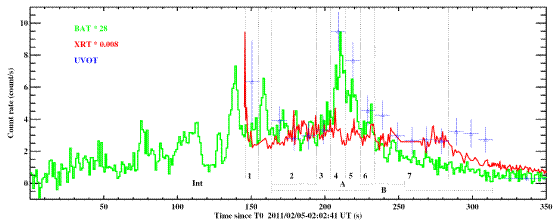
Fig. 1: Prompt gamma-ray, X-ray and optical light curves of GRB 110205A from Swift BAT (green), XRT (red), and UVOT (blue).
The bright GRB 110205A was detected by both Swift and Suzaku. Thanks to its long duration (T90 ∼ 257 s), Swift XRT, UVOT, ROTSE-IIIb, and BOOTES telescopes were able to observe when the burst was still in the prompt emission phase. Broadband simultaneous observations, from optical, X-ray, to γ-ray (1 eV to 5 MeV), are available for nearly 200 s (see Fig. 1), which makes it one of the exceptional opportunities to study the SED during the prompt phase. The broadband time-resolved spectra are well studied. For the first time, an interesting two-break energy spectrum is identified throughout the observed energy range, which is roughly consistent with the synchrotron emission spectrum predicted by the standard GRB internal shock model. Shortly after the prompt emission phase, the optical light curve shows a bump feature around 1100 s with an unusual steep rise and a bright peak (R ~ 14.0 mag). The X-ray band shows a bump feature around the same time. This bump seen in optical and X-ray bands can be interpreted as the reverse shock emission. It is the first time that the rising phase of a reverse shock component has been closely observed. This bump is followed by a more normal decay behavior in both optical and X-ray bands. At late times, a further steepening break is visible in both bands. The full optical and X-ray afterglow light curves can be interpreted within the standard external reverse shock + forward shock model. The rich data in both the prompt emission and afterglowphase make GRB 110205A an ideal burst to study GRB physics, to allow the study of the emission mechanisms (synchrotron radiation) of GRB prompt emission and afterglow, and to constrain the important physical parameters such as the radius of prompt emission (∼3×1013 cm), the initial Lorentz factor of the outflow (∼250), the composition of the ejecta (mildly magnetized), the collimation angle, and the total energy budget. It turns out that the burst can be well interpreted within the standard fireball shock model, making it a “textbook” GRB. From Zheng, W. K. et al., ApJ, vol. 751, p90.
http://apps.webofknowledge.com/full_record.do?product=UA&search_mode=GeneralSearch&qid=2&SID=W215jC6A5LHEklF9iML&page=1&doc=1 |
